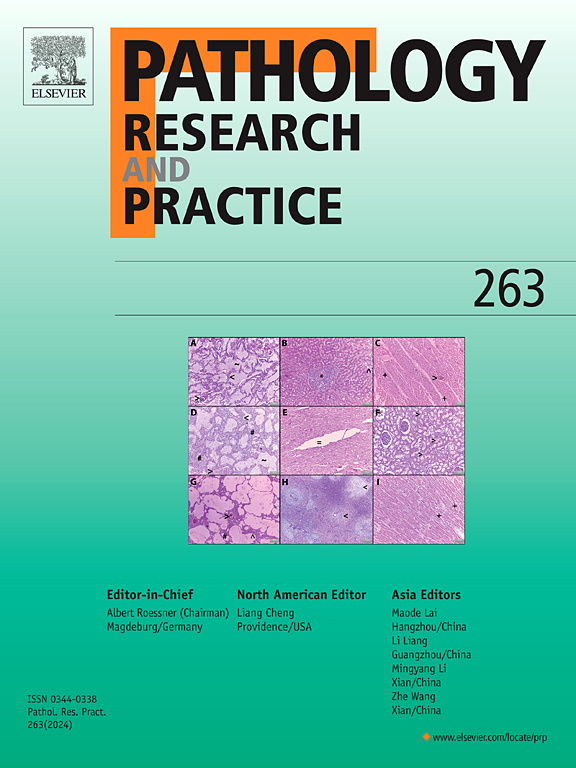鞘脂代谢模式揭示头颈部鳞状细胞癌不同的预后和免疫景观
IF 3.2
4区 医学
Q2 PATHOLOGY
引用次数: 0
摘要
头颈部鳞状细胞癌(HNSCC)由于预后差和死亡率高,一直是全球关注的公共卫生问题。鞘脂是细胞膜的组成部分,由于其在致癌信号传导中的关键作用,正成为癌症的潜在治疗靶点。然而,基于鞘脂代谢与免疫影响的HNSCC预后模型仍然缺乏。方法从TCGA和GEO数据库中获取HNSCC的转录组学和临床数据,从MSigDB中检索鞘脂代谢相关基因。定性上,通过无监督共识聚类对HNSCC患者进行分类。定量地使用Lasso回归构建风险模型。此外,进行单细胞RNA测序分析以进一步研究。最后通过WGCNA分析确定风险模型的核心基因,并在临床标本中进行qRT-PCR和免疫组化验证。我们开发了一种新的五基因预后标记(SPNS2、NEU1、B4GALNT1、CSNK1G2和ARSI)来预测HNSCC的预后。此外,高危组表现出免疫浸润水平下降和微环境抑制。免疫治疗反应分析进一步证明了这种风险分层在指导治疗决策方面的临床应用。此外,核心基因B4GALNT1被证实在临床HNSCC样本中高表达。结论本研究首次在HNSCC中建立了基于鞘脂代谢的五基因特征。它在预测预后和免疫反应方面具有较高的可靠性和准确性,为临床提供了新的前景。本文章由计算机程序翻译,如有差异,请以英文原文为准。
Sphingolipid metabolism patterns reveal distinct prognostic and immune landscapes in head and neck squamous cell carcinoma
Background
Head and neck squamous cell carcinoma (HNSCC) remains a global public health concern due to its poor prognosis and high mortality. Sphingolipids, integral components of cell membranes, are emerging as potential therapeutic targets in cancer because of their critical roles in oncogenic signaling. However, a prognostic model based on sphingolipid metabolism in HNSCC with immune implications is still lacking.
Methods
We obtained transcriptomic and clinical data for HNSCC from TCGA and GEO databases, and retrieved sphingolipid metabolism–related genes from MSigDB. Qualitatively, HNSCC patients were categorized via unsupervised consensus clustering. Quantitatively, a risk model was constructed using Lasso regression. In addition, single-cell RNA sequencing analysis was performed for further investigation. Finally, the core gene of the risk model was identified by WGCNA analysis, and then validated by qRT-PCR and IHC in clinical specimens.
Results
We developed a novel five-gene prognostic signature (SPNS2, NEU1, B4GALNT1, CSNK1G2, and ARSI) to predict outcomes in HNSCC. Furthermore, the high-risk group exhibited a decreased immune infiltration level and a suppressive microenvironment. Immunotherapy response analysis further demonstrated the clinical utility of this risk stratification in guiding treatment decisions. Moreover, the core gene B4GALNT1 was confirmed to be highly expressed in clinical HNSCC samples.
Conclusions
This study is the first to establish a sphingolipid metabolism–based five-gene signature in HNSCC. Its superior reliability and accuracy in predicting prognosis and immune response offer new clinical perspectives.
求助全文
通过发布文献求助,成功后即可免费获取论文全文。
去求助
来源期刊
CiteScore
5.00
自引率
3.60%
发文量
405
审稿时长
24 days
期刊介绍:
Pathology, Research and Practice provides accessible coverage of the most recent developments across the entire field of pathology: Reviews focus on recent progress in pathology, while Comments look at interesting current problems and at hypotheses for future developments in pathology. Original Papers present novel findings on all aspects of general, anatomic and molecular pathology. Rapid Communications inform readers on preliminary findings that may be relevant for further studies and need to be communicated quickly. Teaching Cases look at new aspects or special diagnostic problems of diseases and at case reports relevant for the pathologist''s practice.

 求助内容:
求助内容: 应助结果提醒方式:
应助结果提醒方式:


